+256 760 038002
info@visitafrica.site
Visit Kampala
Kampala, the City of Seven Hills, is the capital city of Uganda and is, by a very large margin, the largest city in the country. Kampala has been ranked the best city to live in East Africa ahead of Nairobi and Kigali by Mercer, a global development consulting agency based in New York City. Secondary to it, is Jinja to the east and Entebbe to the south. Kampala is in the south central part of Uganda, near the northern shores of Lake Victoria.
About Kampala
Kampala is the capital and largest city of Uganda. The city proper was estimated to have a population of 1,650,800 people on 31 July 2019 and is divided into the five boroughs of Kampala Central Division, Kawempe Division, Makindye Division, Nakawa Division, and Rubaga Division. Kampala is reported to be among the fastest-growing cities in Africa, with an annual population growth rate of 4.03 percent, by City Mayors.
Kampala originally referred to only the present-day Old Kampala hill, on whose summit Fort Lugard was located, and the initial headquarters of the British colonialists in the soon to be Uganda Protectorate. Before the British construction and occupation of Fort Lugard, the hill was a hunting reserve of the Kabaka (King) of Buganda and had several species of antelope, especially the impala. As a result, when the British colonial agents were allocated this hill by the then Kabaka (King) of Buganda, they referred to it as "The Hill of the Impala".
Geography
The City of Kampala covers a total area of 189 km2 (73 square miles), comprising 176 km2 (68 square miles) of land and 13 km2 (5.0 square miles) of water. Kampala is a hilly place with its valleys filled with sluggish rivers/ swamps. The highest point in the city proper is the summit of Kololo hill at 1,311 metres (4,301 ft), located in the center of the city and the lowest point at the shores of Lake Victoria south of the city center at altitude of 1,135 metres (3,724 ft).
Climate
Kampala has a tropical rainforest climate under the Köppen-Geiger climate classification system. A facet of Kampala's weather is that it features two annual wetter seasons. While the city does not have a true dry season month, it experiences heavier precipitation from August to December and from February to June. However, it's between February and June that Kampala sees substantially heavier rainfall per month, with April typically seeing the heaviest amount of precipitation at an average of around 169 millimetres (6.7 in) of rain.
History
This area of numerous hills and swamps that later become known as Kampala was part of the core of the highly centralized Buganda Kingdom. It was also the site of the shifting Kibuga (capital) of the different Bassekabaka (kings) of the Buganda Kingdom with each Kabaka (king) upon coronation or subsequently during their reign setting up their Kibuga (capital) on a new and or different hill as they wished or desired. The first written description of this Kibuga (capital) was by the explorer Richard Francis Burton in his book, The Lake Region of East Africa published in 1860. In the book, Burton relying on the information collected by Snay Bin Amir, an Arab trader, described the Kibuga as…the settlement is not less than a day’s journey in length, the buildings are of cane and rattan. The sultan's (Kabaka) palace is at least a mile long and the circular huts neatly arranged in a line are surrounded by a strong fence which has only four gates. In 1862, when explorer John Speke arrived in Buganda, the Kibuga (capital) was at Bandabarogo, present-day Banda Hill, and the reigning Kabaka (King) was Mutesa I. In 1875, explorer Henry Morton Stanley reported the capital as being at present-day Lubaga Hill where he met the same Kabaka Mutesa I. During this visit, Henry Stanley Morton wrote a letter that was published in the Daily Telegraphy, inviting missionaries to come to Buganda.
menu
About Africa
Cities in Africa
Visit Uganda
Visit Kenya
Visit Tanzania
Visit South Africa
Visit Namibia
Visit Zimbabwe
Visit Egypt
Visit Rwanda
Visit Morocco
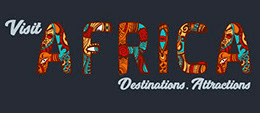
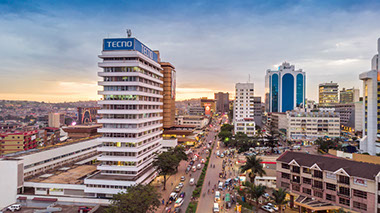
Getting In
- By Plane; When coming to Kampala by air, you will actually arrive in the city of Entebbe, 35 km (22 mi) southwest of Kampala.
- By Rail; Discussions on improving the railway service within Uganda has dragged on for years. While semi-high speed rail is expected to arrive by the mid 2020s, the current 100 year old network is in a dilapidated state. As of the early 2020, the only active line from Namanve in the eastern suburbs of Kampala. The national operator Uganda Railways Corporation has promised to launch intercity trains, but nothing have materialized so far.
Getting Around
There are three methods of public transport: boda-bodas, matatu, and special hires.
- By Boda-boda; The fastest and most dangerous method is the boda-boda: motorcycles that you see all over the city. You won't be in Kampala long before being propositioned by a boda driver. Boda-bodas got their name from the bicycle taxis that operated at some of the busy border crossing points. Buses had to discharge their passengers at the exit border control, who then had to walk to the entry border control.
- By Matatu; Matatus are a series of minibuses that follow relatively pre-set routes all over the city and many other parts of the country. Confusingly, they are known as taxis in Uganda. It might be a bit confusing in the beginning how to use the matatus to efficiently get where you want to go, but it's really not so difficult.
- By Special Hire; If you aren't up for the thrill of the bodas and don't have time for a matatu, taxis, also called special hires, are readily available at most central locations. A few taxis have meters, but most have not. Be sure to agree on the fare before you get in the car or you may be in for a nasty shock.
- By Car Rental; Several agencies offer car rental, with or without driver. While self-driving in Kampala may not seem tempting, car rental is a great option to explore the rest of the country. Upon request, most businesses can get you safely out of Kampala before handing over the keys.
- By City Bus; Large city buses that run on fix routes. This mode of transport is still limited but some buses run along Jinja Road, which has some designated bus stops. all the city buses start at Constitutional square on Kampala road.
379x474.jpg?crc=137408432)
Attractions (What to See)
- National Theatre (Uganda National Cultural Centre), De Winton St (next to Parliament), A big cultural centre with a theatre that also hosts dance shows/lessons/events, comedy, movies, concerts, jam sessions, improv and discussion nights. The current program can be found at the entrance or on-line . There's also a library, a restaurant and a large African Crafts Village with dozens of shops selling souvenirs, crafts, and also some stuff that is more artsy then all the stuff you can find everywhere else. Worth visiting.
- Nommo Gallery, Victoria Ave (next to State Lodge, 400m north-northwest from Sheraton Hotel), Uganda’s National Art Gallery. Calm, spacious, green oasis in the middle of the city with art exhibitions (paintings and sculptures that can be bought) and two restaurants frequented by government employees.
- Uganda Museum (Uganda National Museum), Kira Rd (4km north of city centre, to the west of Kololo hill behind the golf course), A natural history museum, with some static displays commencing from the stone age and moving forward to Ugandan traditional life.
- Uganda National Mosque; Big, beautiful modern mosque commissioned by Muammar Gaddafi, the ex-Libyan despot, as a gift to Uganda and completed in 2007. Said to be second-largest in sub-Saharan Africa. Great, relatively close-up bird's-eye view of Kampala from up the minaret, though there are a lot of steps to climb. Just to the north of the mosque is Fort Lugard where the first Governor of the Protectorate, Frederick Lugard, was posted. USh 20,000 to go inside and up the minaret with a guide.
- Bahai Temple (Bahá'í House of Worship), Kikaya Hill (8km north of city centre, probably best to take a boda-boda or taxi), Beautiful and incredibly peaceful place. Nice view too.
- Kasubi tombs (Ssekabaka's Tombs), Kasubi Hill (5km north-west of city centre along Hoima Rd), Burial ground of four Kabakas (kings) of Buganda and important place for the Baganda people. UNESCO World Heritage site. Nearly completely destroyed in a 2010 fire, but largely reconstructed with foreign aid.
- Wamala tombs (14 km (30 min) north-west of city centre along Hoima Rd, take matatu to Nansana, then boda-boda), Tombs where the remains of some of the earlier Buganda kings were buried including Kabaka Ssuuna 11 (1836-1856). During his time he had 148 wives and produced 218 children! The single tomb building was also completely destroyed by fire in 2012, and has now been reconstructed. Meaning there are no original tombs left in the city.
- Namirembe Cathedral (Buwama), Namirembe Hill (on hill 1km west of Gaddafi Mosque), By European standards, a small Anglican cathedral. Not very interesting of itself, but some views of the city. This is the fifth Namirembe Cathedral in Kampala, built around the time of WW1, after the four first were outgrown, blown down, nearly eaten by termites, and struck by lightning
- St. Mary’s Cathedral (Rubaga Cathedral), Lubaga Hill (1 km west of Mengo Hill). Another cathedral, Catholic this time.
- Lubiri (Mengo Palace), Mengo Hill (large empty hill 1km south of the city centre, seen from most places). Royal compound of the Kabaka/king. Historically significant place, but not much to see. The original Lubiri was destroyed in 1966 when Milton Obote took power and the Kabaka fled the country. To the west along the Lubiri Ring Road is Kabaka's Lake, a man-made body of water ordered by King Mwanga of Buganda that you can walk around or canoe in, but, whew-wee, there's a little bit of a stink problem from sewage going directly into it.
- Parliament of Uganda, Parliament avenue (from the taxi parks walk east along Kampala/Entebbe Rd until you reach Parliament Ave). Designed to represent the whole country and with visitors/tourists in mind; eg, look at the gate with the symbols of Uganda's different tribes or the giant carved wood art covering the lobby walls.
- Independence Monument, Speke Rd/Nile Ave (between Grand Imperial and Sheraton hotels). Small monument, but of large symbolic importance.
- Shri Sanatan Dharma Mandal Temple, 10 Snay Bin Amir Rise, A longstanding Hindu temple in Kampala where the emphasis is on Lord Shiva.
- Uganda Martyrs Catholic Shrine Namugongo, Naalya-Namugongo Rd (about 9 mi from Kampala CBD), Shrine to the 32 men who were burned to death on order of King Mwanda II of Buganda in 1886 for refusing to renounce Christianity back in turbulent colonial times.
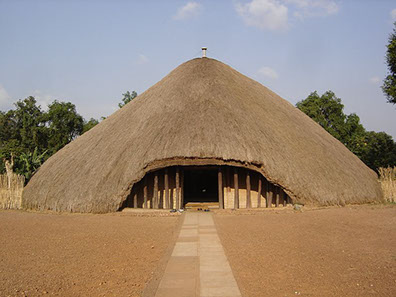
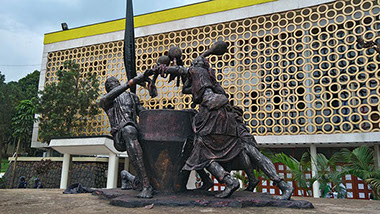
Where to Stay (Accommodation)
Budget:
- Lusam Inn Resthouse, Namirembe road, Double room with own bathroom a walk uphill from the Taxi Park.
- New City Annex, De Winton road (opposite National Theatre), Clean fan single/double rooms with outside hot water bathroom.
- New Diplomat, William street (behide equatoria mall). Single/double room with own bathroom.
- Hotel New Gloria, William street (behide equatoria mall), Single/double rooms with own bathroom and TV.
- Marie Hotel, Martin road (just off Namirembe road)
- Mukwano Guest House, plot 27 Nakwano Place Road. Single/double rooms.
- Kawanda Country Inn, off Bombo road (near Mo-Petro). Fan double room with own bathroom and TV and free breakfast.
- Medina Guest House, Kaboowa Road and Church Road. A/C double room with own bathroom. TV and free breakfast.
- Hotel Harambe, Plot 14-18 Nakivubo Place Road (2nd floor venus Plaza.). Twin/double rooms with own bathroom and cable TV. Has free WiFi.
- Tuhende Safari Lodge, Martin Road, Has a dorm with 3 beds per dorm.
- Jotena Hotel, 80 William Street (next to the Philippines Consulate), Big clean fan single/double rooms with own hot water bathroom, TV, internet, free breakfast.
- Dolphin Guest house., plot no 26 william street (Near old taxi park), Single/double rooms.
- I C U Guest house, Bazzekuketta Road.
- Hotel City Square, Plot 42 Kampala road (Constitution Square.), single/double rooms with own bathroom. Internet and breakfast.
- Selam Restaurant and Lodge, Ggaba road Kansanga (150m behide Kampala Int University.). Single rooms
Mid-Range;
- Prestige Hotel Suites, Plot 9 Lumumba Avenue, Nakasero, Air-conditioned suites with a swimming pool, bar, lounge, free parking and 24-hour reception. Fast free on-site Wi-Fi available.
- Hotel International 2000, Plot 3209 Tank Hill Road, Offers 30 tastefully furnished, giant-sized and standard rooms ranging from single to executive with other ammenities like health centre, swimming pool, bar and restaurant, coloured gardens, conference halls, Wifi, wide parking space.
- Protea Hotel Kampala, Kololo. 35 km from Entebbe Airport, the brand new Protea Hotel Kampala offers 4-star luxury and 5-star service. 59 rooms and 11 suites, all en-suite and air-conditioned; restaurant, bar, satellite television, air-con. Close to gym, tennis and squash courts, etc. Also includes a business centre, wireless internet throughout, currency exchange, 24-hour room service and Reception.
- Hotel Africana, Plot 2-4 Wampewo Ave, Well-established hotel with lots of parking, swimming pool, gym, Wi-Fi, apartments; near a large shopping mall but can be noisy on a concert/wedding weekend. Only hotel with its own fully-fledged mosque. edit
- Fang Fang Hotel on Ssezibwa Road in Kampala has clean rooms, air-con available, hot running water, a great Chinese restaurant on the premises (with nice garden seating), and is not overpriced. Recommended. Centrally located near UWA offices.
- Aminaz Garden Place (In Kololo). Very good, clean and safe accommodation
- Golf Course Apartments, in Kololo. Not to be confused with pricier Golf Course Hotel which is fairly nearby. Very comfortable apartments. Offers swimming pool, gym, sauna, tennis court, garden. Kitchens fully equipped for self-catering. Daily maid service, cleaning, laundry. Pleasant green environment away from traffic noise.
- Speke Hotel, City Center, in City Center. One of the earliest hotels in Kampala, and very different from the upscale Speke Resort in Munyonyo. It is on a busy street where prostitutes ply their trade at night. The rooms are clean with wooden floors and clean toilets, AC, free Wi-Fi, but it tends to be spartan, and isn't posh by any stretch. The hotel has a pizzeria, Indian restaurant (Khyber Pass), A pub/bar Rock Garden Cafe.
- Shangri-la Hotel, Plot 8/10 Ternan Avenue, Nakasero (right across from the Sheraton Hotel), Budget place with breakfast and pool close to the Independence monument and other downtown attractions.
Splurge;
- Golf Course Hotel, Plot 64-86, Yusuf Lule Road, This hotel next to the Garden City Complex offers huge rooms and apartments, modern facilities, a large and fancy pool and very relaxing views of the tropic golf course.
- Kampala Serena Hotel, Kintu Road, Another five-star hotel just further down the road from the Sheraton. Offers modern and spacious rooms. Swimming pool, large garden, a health club and also several restaurants and bars are all on the hotel premises. The hotel is also close to the popular shopping malls at Yuseuf Lule road.
- Sheraton Kampala Hotel, Ternan Avenue, Renovated, the Sheraton is the leading high-end hotel in town, occupying extensive nicely manicured grounds.
- Speke Resort, In Munyonyo, about 10 km from the city centre by the shores of Lake Victoria, and not to be confused with the Speke Hotel (above). An excellent getaway from city life. You'll find plenty of animals around (and often in) the resort. Has a large swimming pool, as well as an infinity pool by the lake. Gym, spa, and choice of restaurants with lake views. Free cable internet to rooms, but Wi-Fi only in the foyer and restaurant areas
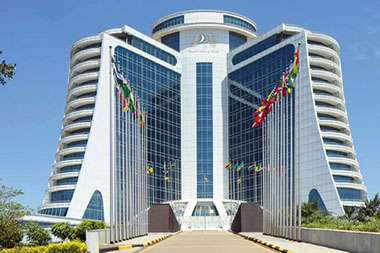
Visit Africa is an African tourism brand of Architect Tourism SMC, that profiles every tourist destination, in every country, in Africa; Destinations, How to get there, Attractions, Things to do, How to get around, itinerary pricing and Where to stay, for an adventurous breathtaking and thrilling experience of tourism of Africa.
Visit Africa
Destinations
We are Social!
Search this Site!
About Africa
Visit Africa
Visit Uganda
Tanzania
Visit Kenya
Visit Egypt
Cities in Africa
Visit Morocco



Visit South Africa
Visit Namibia
Visit Zimbabwe
Wildlife in Africa
Visit Africa Copyright © 2019 - Visit Africa is a Tourism Brand of Architect Tourism SMC Limited.
Architect Tourism SMC is an African tourism company, crafted to inspire and enable a breathtaking beautiful experience of Africa. Visit Africa is one of Architect Tourism SMC tourism brands. Visit Africa is inspired to craft innovative, fun and breathtaking tourism events, trips, excursions, getaways, safari, vacations, holiday, and tours experiences.
Vision: To inspire, craft, and enable a breathtaking beautiful experience of Africa.
Our Values: African, Oneness, Integrity, Client focused, Conservation focused, Innovative, Excellence, Simplicity.
Company Registration Number: 80020002986484
Company Tax ID: 1018106912
